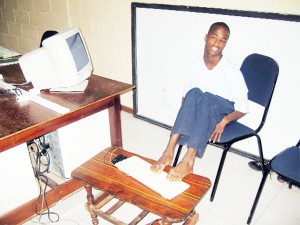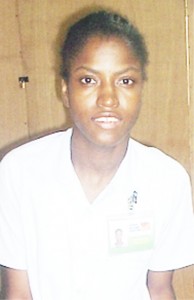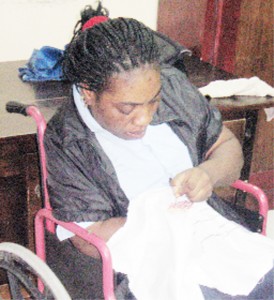Like most young people his age, 19-year-old Norris Cummings is fascinated with technology. He loves computers and is an information technology student.

Unlike the majority of his peers, however, Cummings was born with the physical disability of cerebral palsy. Cummings’ upper limbs are affected. His brain function is also somewhat limited and he has a speech impediment as well.
Despite all that, he can type at a fairly decent speed, using his toes. He also uses his feet to control the computer mouse.
Cummings’s speech comes out as mostly sounds. But he obviously likes being photographed as he could be heard saying cheese when this newspaper approached him with a camera.
Cummings is a student at the National Vocational Training Centre for persons with disabilities or the Open Doors Centre in Sophia, and will complete his studies in May, graduating with a certificate in Information Technology in July after completing a 12-week job placement stint.
Manager of the vocational centre Arthur Lewis said that though the centre focuses on skills training with the intention of having its graduates gain employment or become self employed, placing people with disabilities was a challenge. Nevertheless, in collaboration with the private sector, the employers’ organisation and the trade unions it is looking to secure placements for all graduates.

Thirty-three-year-old Adonica McDonald is also an information technology student at the centre. The Lamaha Street, Newtown resident was also born with cerebral palsy, but in her case it affects the lower extremities. She can capably use her hands but has no muscle control in her feet. Movement is impeded to the extent where she has to rely on crutches to get around. As a result of this medical condition her brain function is limited as well; she also has a speech impediment.
In spite this, her hobby is reading and she has the ability to retain and recite lengthy passages in a matter of minutes.
“I really enjoy reading a lot,” McDonald said in an interview with this newspaper. I would read anything that I can put my hands on, but I like the newspapers, books and magazines best.”
She also likes cricket. “I am a huge cricket fan and I back West Indies, that is, whether they are winning or losing.”
Always smiling
McDonald, who wore a smile throughout the interview, is the eldest of four children and as she puts it, “they are normal.” She told Stabroek News, “I do everything for myself, from taking care of me to preparing my own food.
“I live with my mom,” she pointed out, but quickly emphasised that she can do things for herself and also that she assists with household chores.
The former Stella Maris primary and Campbellville secondary school student explained that though she was born with cerebral palsy, she walked unaided until one day while in first form, she lost total muscle control in her legs.
She advised schoolchildren to make the best use of every opportunity that they have been given to be educated and to enjoy their childhood. According to her, being born with cerebral palsy has helped her to accept it as opposed to acquiring the condition along the way. “I don’t really have regrets for the way I was made, but they are times that I wish I could have led a more normal life,” she concluded.
McDonald also graduates in July with a certificate in Information Technology.
Stabroek News also spoke with 38-year-old garment construction trainee, Grace-Ann Scipio, who suffers from spastic paralysis. She was also born with this medical condition, but unlike McDonald and Cummings, Scipio is shy and did not say much.
She has muscle control in only one hand, yet all of the garments she makes are handmade. To thread a needle, Scipio sticks it into a piece of sponge and then uses her hand to guide the thread through the eye. When she is ready to sew, she would place the fabric over her legs or drape it over her disabled arm.

According to Lewis, July marks the end of a two-year programme for 24 students of the Open Doors Centre and a new batch will be enrolled for the new academic year which begins in September.
“At the Open Doors Centre, we like to think of our students not as being disabled, but rather, differently-abled. Like any other person, they too have the ability of attaining outstanding achievements and making their mark in society.”
About the centre
The Open Doors Centre caters for the provision of vocational training for persons with both physical and mental disabilities. The institution offers free training in the fields of carpentry, electrical installation, garment construction and information technology.
The centre was established in 2000 through a project promoted by the Italian NGO Associazione Italiana Amici di Raoul Follerau (AIFO) and co-financed by the European Union. This project was developed in collaboration with the Ministry of Health, more precisely with the Rehabilitation Services of the ministry. It was handed over to the ministry in 2003.
According to Lewis, in a statement, the need for establishing a national vocational training centre for persons with disabilities had been strongly highlighted during the phase of planning and formulation of the overall project which is aimed at strengthening the rehabilitation services in Guyana. With the general shortage of resources and facilities for persons with disabilities, the absolute lack of vocational training for this particular target group had emerged as a highly critical factor.
In fact, Lewis noted that as regards education services for persons with disabilities, Guyana has only one special school which is based in Georgetown and serves the needs of the hearing and intellectually impaired children. The city also has a centre for physically handicapped children (Ptolemy Reid Rehabilitation Centre) and a unit for visually impaired children attached to a regular school. There are two very small units serving differently-abled children in two rural towns and there is a residential home (Cheshire Home at Mahaica) that serves children and young adults.
He said that at the Open Doors Centre, great emphasis is placed on employment, to underline that the main task of the centre is to provide not only training but also secure employment for its students in the form of job placement in the enterprise or self-employment.
Underscoring the need for employment for the disabled, Lewis noted that most people with disabilities were forced to live at home with their parents since they had no income that would enable them to achieve personal independence. To help them achieve this, he said, the Open Doors Centre has established contacts in the job market to promote the creation of a network that ensures that persons with disabilities, once they are adequately trained, can access real opportunities for employment thus making students equally competitive in the labour market.
As it relates to self-employment, some modules relevant to topics such as project management, business management, accountability and marketing have been included in every curriculum. This is aimed at ensuring that all trainees have the basic management knowledge to start-up their own businesses, in case the market is not receptive or the trainees themselves prefer to own their own small business.
Display
Students of the centre on Wednesday gave an impressive display of their skills in carpentry, electrical installation, garment construction and information technology.
U.S. Ambassador to Guyana John Jones who was present congratulated the students on a job well done and he said that the United States has always been actively involved in undertakings of this nature. He also gave a commitment to assist the centre by providing the tools and materials necessary to “truly keep its doors opened.” Jones in his brief remarks encouraged the administration to keep alive “their efforts of developing the lives of differently-abled children.”
Charles Miller, Programme and Training Officer of the Peace Corps, who was also at the exhibition said, “I am personally impressed by the work of the students.” According to him, there is a wealth of potential in the students. The Peace Corps is actively involved in providing volunteers for the institution, and Chase Chisholm is a volunteer in the information technology department.
The exhibition was held at the centre’s Sophia location and also present were Barbara Lawrence; Director, Rehabilitation Services, Ministry of Health and Dr. Shellon Bovell, Programme Manager, Peace Corps, Guyana.




